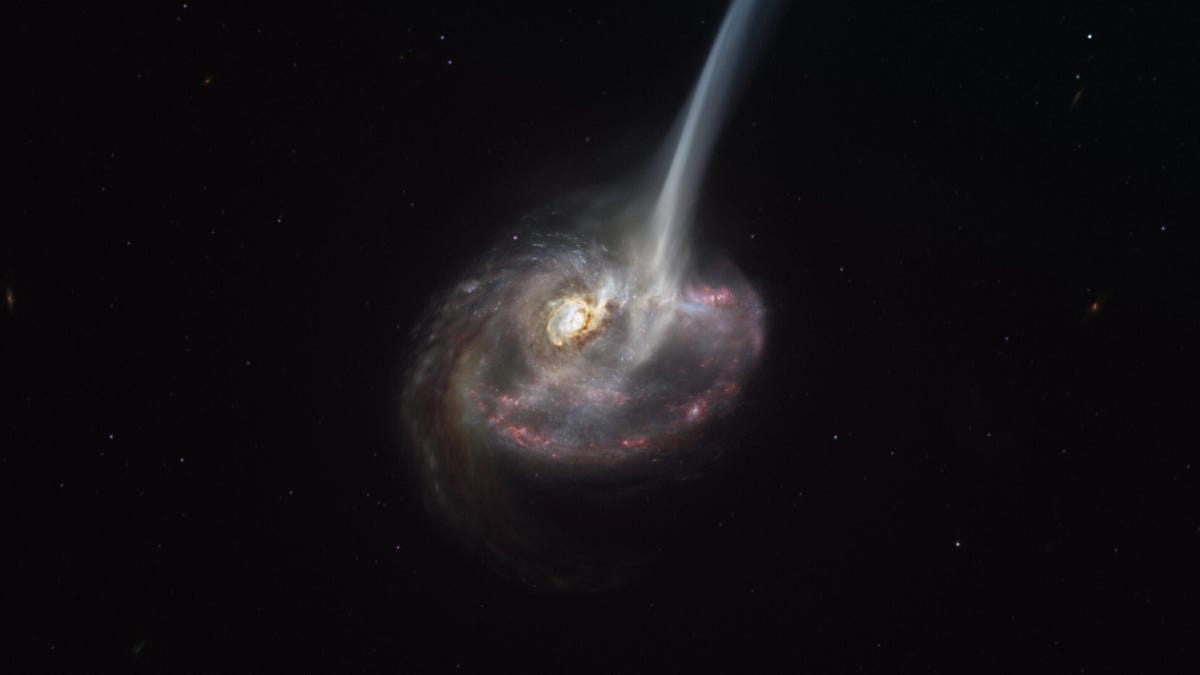ALMA telescope spots ancient galaxy collision spewing titanic amount of gas
Two spiral galaxies collided in the early universe. Researchers believe it could explain how galaxies stop growing.

An artist's impression of ID2299, a remnant of two galaxies that collided in the ancient universe.
The world's largest radio telescope has captured a violent moment in the early universe, some 9 billion years ago, shortly after the collision of two gigantic spiral galaxies. Astrophysicists believe the snapshot could provide some key insight on how galaxies grow and evolve -- and potentially what causes them to stop growing.
The research, published in the journal Nature Astronomy on Monday, describes observations of the starburst galaxy ID2299, made by the Atacama Large Millimeter/submillimeter Array, or ALMA. After looking at over 100 galaxies, the ALMA team found ID2299 and discovered it was undergoing a "truly extreme event," according to Emanuele Daddi, a co-author and astrophysicist at the French Alternative Energies and Atomic Energy Commission (CEA) Saclay.
As a starburst galaxy, ID2299 is undergoing a period of rapid star formation, where hot gases and dusts are accumulating and producing new stars about five times faster than average. Over time, as galaxies use up their dust and gas forming stars, that process slows down dramatically and the structures settle into a mature phase of growth that's far less busy.
ID2299 is a little unusual. We're seeing it from a time when the universe was only around 4.5 billion years old. It's making a lot of stars, but the researchers note it also seems to be vomiting a ton of gas into the void, in a huge stream.
They use a much friendlier term than "vomiting," however. They call it a "titanic ejection."
Cool.
The team theorizes that this huge ejection, which is equivalent to about half of the total mass of the galaxy's gas, was likely caused by two spiral galaxies spinning into each other, causing gravity to get all weird. The interactions between the two merging galaxies helped expel the gas quickly. However, it's the implications of their find on galaxy growth and evolution that really excites them.
A computer simulation of gaseous galaxies colliding and merging, ejecting large amounts of gas in trailing "tails."
When star formation drops away, galaxies enter the last phases of their life (which lasts for a few billion years), but how formation stops has been something of a mystery. Some astrophysicists speculate galactic winds caused by black holes or intense star formation might push gas out of a galaxy and quench star formation. But the new research shows star formation could be quenched by these mammoth collisions, too.
"The gravitational interaction between two galaxies can thus provide sufficient angular momentum to kick out part of the gas into the galaxy surroundings," said Annagrazia Puglisi, an astrophysicist at Durham University and first author on the paper.
"This suggests that mergers are also capable of altering the future evolution of a galaxy by limiting its ability to form stars over millions of years and deserve more investigation when thinking about the factors that limit galaxy growth."
Puglisi's team used computer simulations to show the titanic ejection is most likely caused by the merger, rather than black holes or increased star formation in ID2299.
The researchers also suggest that this event might be common in the early universe and that other galactic ejections could be the result of colliding galaxies, challenging some of the previous research into how winds blow galactic gases into the dark of space.
To help bolster the new hypothesis, the team will study other distant galaxy mergers and try to constrain the possible causes of titanic ejections even further.
"This might have huge consequences on our understanding of what actually shapes the evolution of galaxies," said Jeremy Fensch, an astrophysicist at the Centre for Astronomical Research of Lyon and co-author on the paper.

